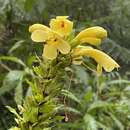Comprehensive Description
(
англиски
)
добавил Smithsonian Contributions to Botany
Aphelandra acanthus Nees
Aphelandra acanthus Nees, in de Candolle, Prodr. 11:302. 1847.—Leonard, Contrib. U.S. Nat. Herb. 31:142. 1953.
Aphelandra quercifolia Nees, in de Candolle, Prodr. 11:302. 1847.
Aphelandra phobera Leonard, Contrib. U.S. Nat. Herb. 31: 143. 1953.
Aphelandra gilva Leonard, Contrib. U.S. Nat. Herb. 31:704. 1958.
Coarse suffrutescent shrubs or small trees to 3 m high; stems fleshy (at least the upper portion), spiny, hirsute to subtomentose, the hairs yellowish, upwardly appressed or some of them more or less spreading, the lower portions of the stems glabrate; leaf blades oblong to oblong-lanceolate, to 50 cm long and 15 cm wide, acute to acuminate at tip, narrowed at base, thin, shallowly to deeply incised, the lobes triangular, ascending, 2–5.5 cm from sinuses to tip, the margins serrate-dentate, the teeth triangular, 3–4 mm long, these and the tip armed with sharp yellowish spines to 5 mm long, both surfaces more or less hirsute, the hairs confined chiefly to the costa and veins (about 20 pairs), appressed or ascending, the venation rather prominent, the veinlets coarsely reticulate; petioles 1–6 cm long, the pubescence similar to that of the stem; interpetiolar bracts ovate, to 5 mm long and broad, the nerves thick, terminating in 3–10 sharp, straight, yellowish, spreading or retrorse spines 2–10 mm long, these hirsute or glabrate; flowers numerous, borne in simple, compact, terminal spikes to 30 cm long at maturity and 2.5–4 cm broad (excluding corollas), more or less lax toward base, the pubescence of the rachis similar to that of the stem; bracts lanceolate to oblong-ovate, 1.82.5 cm long and 9–12 mm wide (the lowermost somewhat longer and relatively narrower, resembling a small leaf blade) acute to acuminate, glabrous or sparingly hirtellous, the hairs more numerous on the outer surface than on the inner, the margins serrate, bearing 3–6 pairs of teeth, these and the tip terminated by sharp, yellowish, ascending, sparingly hirsute spines to 3 mm long; bractlets lanceolate, 11–18 mm long and 2–3.5 mm wide near base, gradually narrowed to a slender tip, the costa excurrent, terminating in a small spine, sparingly and minutely pubescent without, glabrous within, the margins ciliolate; calyx segments oblong-lanceolate to oblong-ovate, 10–14 mm long, 3.5–5 mm wide, abruptly narrowed to an acute tip. striate-nerved, finely puberulous and ciliolate, each segment terminating in a slender spine to 1.5 mm long; corolla yellow, 4–6 cm long, the tube densely yellowish tomentose except the basal portion, this glabrous, the hairs ascending, the tube oblique, curved, 5–10 mm broad at base, narrowed above ovary from 4–6 mm, thence gradually enlarged, the throat 8–10 mm broad, the upper lip erect or slightly recurved, 14–20 mm long, about 7 mm wide near base, bilobed, the lobes oblong-obovate, 8–15 mm long and 4.5–8 mm wide, rounded and emarginate, the lower lip more or less spreading, the lobes obovate, 8–11 mm long, about 6 mm wide, rounded or shallowly emarginate; stamens reaching or slightly exceeding the upper lip of the corolla; anthers 7.5–10 mm long, 2–3 mm broad, rounded at each end, glabrous; ovary glabrous; capsule brown, oblong, nitid, about 1.5 cm long and 6 mm broad.
TYPE.—Humboldt 5836 (holotype B, F photo 8695), Colombia, Tolima, Quindío.
DISTRIBUTION.—Andean Colombia, Ecuador and Peru at elevations between 2000 and 3400 meters. COLOMBIA. PUTUMAYO: La Cabaña, old river basin of the Río Putumayo in Valle de Sibundoy, 2 Jan 1941. Cuatrecasas 11631 (US). TOLIMA: Quindío, Bonpland s.n. (P); Mariquita, Quindío, 1350 m alt, Feb 1843, Linden 1101 (P); Quindío, La Palmita, Nov 1845, Goudot s.n. (K, holotype of A. quercifolia Nees, isotype P); Mariquita, La Palmita, Quindío, 2200 m alt, 1851–1857, Triana s.n. (K, P, NY, W); Quindío, Nov 1853, Holton 592 (K); Quindío, Purdie s.n. (K); along the Quindío Highway, between Cajamarca and summit of Divide, 3050 m alt. 27–28 Mar 1939, Killip & Varela 34685 (US); El Libano to Murillo, Alto de Penones, 2200–2950 m alt, 20 Jul 1947, Garcia-Barriga 12273 (US); without exact locality, André 2047 (K). ANTIOQUIA:Jarvise s.n. (K). CALDAS: Alaska, above Salento, 3000–3400 m alt, 10–13 Aug 1922, Pennell 9704 (GH, US); banks of the Río Otún, above Penas Blancas, 3000 m alt, 27 Nov 1946, Cuatrecasas 23321 (US). VALLE: Along Río Cali, between Puente de los Cárpatos and La Margarita, 2000 m alt, 2 Nov 1944, Cuatrecasas 18484 (US, holotype of A. phobera Leonard); La Albania, valley of the Río Amayme, 3000–3100 m alt, 2 Feb 1965, Cuatrecasas 26838 (US). CAUCA: Crest of Cordillera Occidental, W of Tambo, 2500–2600 m alt, 5 Nov 1946, Haught 5174 (US); San José, San Antonio, 2400–2700 m alt, 28 Jun 1922, Pennell & Killip 7392 (US); Canaan, Mount Puracé, 2900–3100 m alt, 11–16 Jun 1922, Killip 6796 (US). NARIÑO: Páramo of El Tábano, near Pasto, 3150 m alt, 30 Jul 1965, Uribe 5342 (COL); vicinity of Funes, near Río Tellez, 2600 m alt, 1 Dec 1944, Ewan 16501 (US, holotype of A. gilva Leonard); Quebrada Panacual, 8 km S of Piedrancha, Río Guaga drainage, 2800 m alt, 3 Oct 1943, Fosberg 21113 (US); Ipiales, Victoria highway to San Jorge, 2100 m alt, 23 Jun 1962, Mora 2172 (COL, US). WITHOUT LOCALITY: 1760–1808, Mutis 1944 (US); Purdie s.n. (K). ECUADOR. PICHINCHA: Below San Juan toward Chiriboga, 2900 m alt, 31 Dec 1955, Asplund 18982 (S); road Chillogallo-Chiriboga, between the village and km 48, 1600–2000 m alt, 12 Jun 1967, Sparre 16974 (S). CHIMBORAZO: Road of Pusucucho al Placer, 2850–3500 m alt, 10 Feb 1944, Acosta 7279 (F). NAPO-PASTAZA: Cosanga, 1900 m alt, 11 Jan 1940, Asplund 10329 (S); Papallacta, 27–29 Jan 1959, Harling 3927 (S); Santa Bárbara, 2700 m alt, 15 Jul 1955, Asplund 16916. PERU. JUNIN: Oxapampa, 1600 m alt, Aug 1944, Soupkup 2403 (US).
- библиографски навод
- Wasshausen, Dieter C. 1975. "The genus Aphelandra (Acanthaceae)." Smithsonian Contributions to Botany. 1-157. https://doi.org/10.5479/si.0081024X.18

